| Gear: Energy | |||
|
Superconductive Magnetic Energy StorageEnergy is stored in Superconductive Magnetic Energy Storage (SMES) units - toroidal superconducting solenoids, wrapped with thick carbon nanotube fabric for support. As inductors, they can be charged and discharged rapidly – for practical purposes, energy can be withdrawn as fast as it is needed, and the SMES can be recharged as rapidly as electrical energy can be added. SMESs are used to store energy for off-grid devices, from radios to automobiles. Most SMES are recharged within the device they power, by plugging an adapter into a wall socket and the adapter cord into the device, or by placing the device or SMES on an inductive charger. Large SMES packs either dock the adpater cord directly or are wired into the household power grid. Because the active volume of a SMES is a torus shape, they are often called energy bagels or energy doughnuts.
SafetySMESs are common consumer items in the Verge. They are the most popular form of energy storage for their compactness, reliability, and long lifetime. However, they do contain a large amount of circulating energy for their size. If this energy can all be released at once, it can cause a harmful explosion. This can occur if the structure of the SMES is badly damaged, if it is exposed to extreme temperatures for long enough to heat through (Temperature score of +4 or more), or extreme magnetic fields (at least tens of tesla – fields this high are not encountered in everyday life but might be found in certain research labs or industrial facilities).To prevent this, commercially available SMESs are equipped with many safety features. To start with, they are heavily armored simply by virtue of the strong backing material needed to hold them together when fully energized. They have high engineering safety factors, able to withstand strains, currents, and fields well above the rated limit. Software and hardware interlocks prevent over-charging. The design contains many redundancies, so that current can be routed away from damaged loops or compromised backing material and stresses can be distributed through the backing to relieve excess strain in any one location. Damage to the superconductor or backing will trigger fail-safes that begin de-energizing the SMES by routing some of the current safely through a resistor; within several minutes it will be completely de-energized and then permanently disabled so that it cannot be energized again. Tamper detection devices will automatically trigger this bleed-off and disablement if someone tries to break in to the SMES unit. Sustained high temperatures (Temperature scores of +3 or more) will also trigger this bleed-off, as will extreme magnetic fields (on the order of ten tesla). If all else fails and an explosion is imminent, the software will trigger a controlled quench. The superconductor is made non-superconducting, and the circulating current immediately heats the formerly superconductive layer to a vapor. Although this vapor is very hot and high pressure, it is lower pressure than the magnetic forces so the stress on the unit immediately drops. Unfortunately, the extreme heat of the quench soon diffuses through the backing (partially vaporizing the interior backing as well) until the surface is heated to a blazing yellow-white temperature (and the surface also ignites in an oxygen atmosphere, although this is insignifcant compared to the heat leaking out). While this allows it to cool off without exploding, it also poses a significant fire hazard. Needless to say, that SMES will never work again. In the event of catastrophic failure, usually the result of extreme sudden damage to the unit, the SMES will explode. It initiates with a brilliant blue-white arc flash followed by the usual blast, fireball, and rising cloud of smoke, dust, and debris. If a SMES unit is damaged, roll 2d6 + Toughness score with a target number of the injury score. On a success, the SMES triggers the bleed-off resistor safety feaure but otherwise does nothing unexpected. A failure initiates a controlled quench. Use the supplied table for the effects, reading subsequent stages and their duration in rounds left to right, A failure by 2 or more results in an explosion. The damage for the explosion from a fully charged SMES is listed. For each RS down in the stored energy of the SMES from its maximum capacity, add +1 to its Toughness for figuring the effect of damage. 80% of the energy of a fully charged SMES is dumped during a controlled quench when the temperature score is +8. Partially charged SMES units decrease the duration of the time the SMES remains at Temperature Score +8 (or Row Shifts the Penetration down appropriately for the reduced energy if the duration is already below the limit of resolution). If it has less than 20% of its energy left, adjust the sequence of dissipating energy as you see fit, eliminating all Temperature Score +8 periods and then eliminating the highest temperature score periods before lower temperature score periods. In practice, tracking the exact sequence of burning progression is not usually necessary - the quenched SMES unit will just set aflame anything flammable it is in contact with (or even just nearby for those with a listed Pulse damage, which is caused by the radiant heat) and melt or burn some distance down into whatever material it is in or on. In addition to fire and blast hazards, SMES contain large amounts of circulating electricity. Normally this is passively safe – electric current follows a path of least resistance, and the superconductive loops have literally zero resistance. Until the loop is opened, no current will flow out through any other object touching the loop. Direct electrocution from a SMES is difficult. The victim must be in direct electrical contact with both terminals. This includes touching conductors that are in contact with the terminals, but if the electricity must go through electrical equipment or electronics use the effects of a suitable appliance instead of the SMES. The SMES must be in a closed state, then switched to an open state when the victim is in contact. Further, this will only occur if the safety interlocks are disabled and if the SMES is energized. In order to get a significant current path across the victim, simple contact with the terminals alone is unlikely to lead to much in the way of electrocution, since the current path is too short. Instead, you need at least one point of contact to be with a conductor that is also connected to a terminal. Despite this, occasionally someone manages to do everything exactly wrong and ends up zapping themselves. Someone poking around inside an energized SMES must succeed a task of Smarts + Fix and Build (electronics) skill with a DC of 1 to avoid electrocution. If the roll would not pass a DC of 9, the tinkering trips the SMES's fail-safes and causes an immediate bleed-off of stored energy followed by bricking of the SMES. Breaking in to a SMES unit in this way does allow these normal consumer devices to be used for nefarious purposes. Once the tinkerer has gotten past the fail safes, it takes a DC 5 Fix and Build (electronics) roll to rig a thermal charge that can controllably initiate a controlled quench, or a DC 8 Fix and Build (electronics) roll to set up the SMES as a bomb that can detonate reliably when triggered. For DC 10, the blast can be tailored to enhance either the arc flash (thermal Pulse damage equivalent to double the stored energy; explosion effects equivalent to 1⁄5th the stored energy) or arc blast (explosion damage equivalent to double the stored energy, thermal Pulse effects equivalent to 1⁄5th the stored energy). Familiarity with working with SMES and with the particular make and model of SMES applies to all Fix and Build rolls done to break into or modify them.
Solar GeneratorsPhotovoltaic panels can be used to generate electric energy in well-lit environments. The listed power generated is under typical conditions with a Sol-like sun at a distance of the sun's distance from Earth. This assumes partly cloudy skies at mid-day in summer with the panels at about a 45° angle from the sun's rays. This can change according to weather conditions. Increase the power by up to ×2 for perfectly clear skies or ×2½ if there is no atmosphere at all. Fully overcast conditions can decrease the power by ×1⁄2 to ×1⁄4. Winter or evening can reduce the power by another ×1⁄2; more for late evening, and no power at all at night. Facing the panels directly into the sunlight is good for another ×1.5. Any number of solar generators can be connected together to add their powers.
NOW GeneratorsNon-orientable wormholes (NOWs) make up the heart of most power distribution grids in the Verge. NOW generators are large – even the smallest models need to be transported on a semi-trailer. Most are massive instalations that make use of the increased efficiency afforded by their scale. The NOW at the center of a generator is a fickle device whch may self-destruct if not tended carefully. Its fuel is hydrogen gas in minute quantities.
| |||||||||||||||||||||||||||||||||||||||||||||||||||||||||||||||||||||||||||||||||||||||||||||||||||||||||||||||||||||||||||||||||||||||||||||||||||||||||||||||||||||||||||||||||||||||||||||||||||||||||||||||||||||||||||||||||||||||||||||||||||||||||||||||||||||||||||||||||||||||||||||||||||||||||||||||||||||||||||||||||||||||||||||||||||||||||||||||||||||||||||||||||||||||||||||||||||||||||||||||||||||||||||||||||||||||||||||||||||||||||||||||||||||||||||||||||||||||||||||||||||||||||||||||||||||||||||||||||||||||||||||||||||||||||||||||||||||||||||||||||||||||||||||||||||||||||||||||||||||||||||||||||||||||||||||||||||||||||||||||||||||||||||||||||||||||||||||||||||||||||||||||||||||||||||||||||||||||||||||||||||||||||||||||||||||||||||||||||||||||||||||||||||||||||||||||||||||||||||||||||||||||||||||||||||||||||||||||||||||||||||||||||||||||||||||||||
 Button SMES: A small, flat, round pack made of concentric SMES rings, altogether about the size and shape of a dime. Primarily for powering small consumer electronics.
Button SMES: A small, flat, round pack made of concentric SMES rings, altogether about the size and shape of a dime. Primarily for powering small consumer electronics.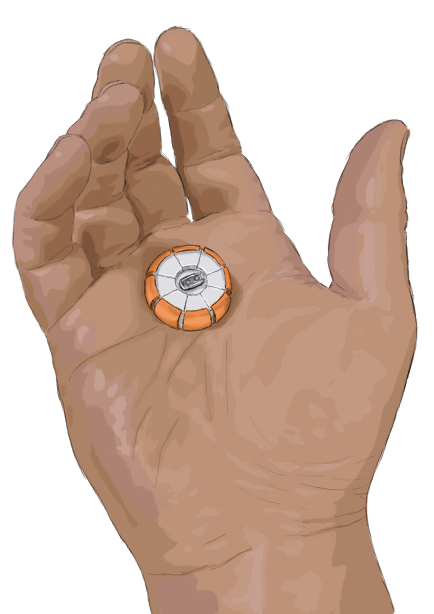
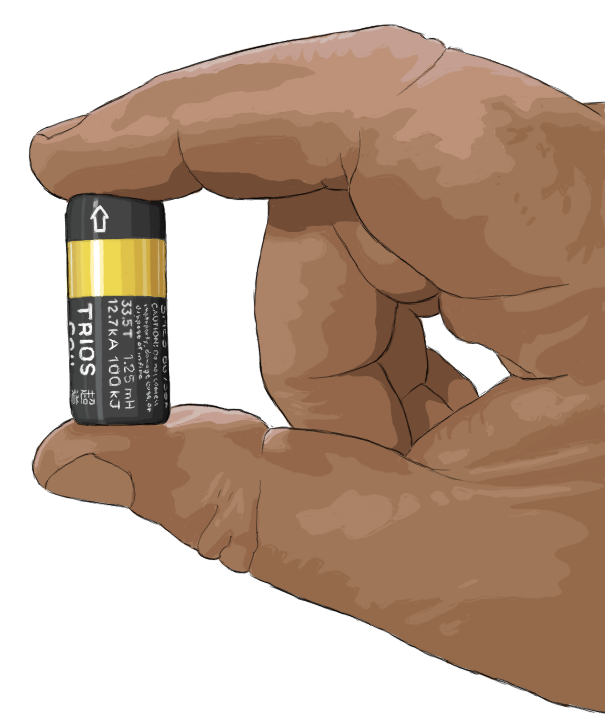
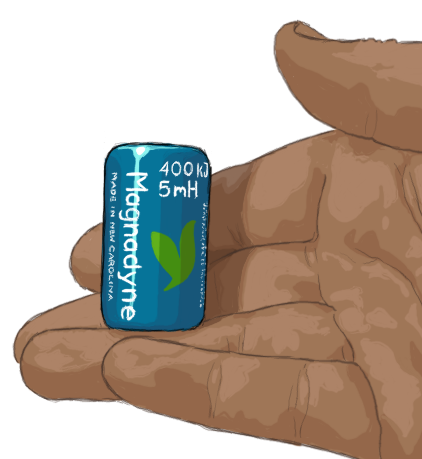 Lantern SMES: A cylindrical SMES stack about the size of a modern C-cell battery.
Lantern SMES: A cylindrical SMES stack about the size of a modern C-cell battery.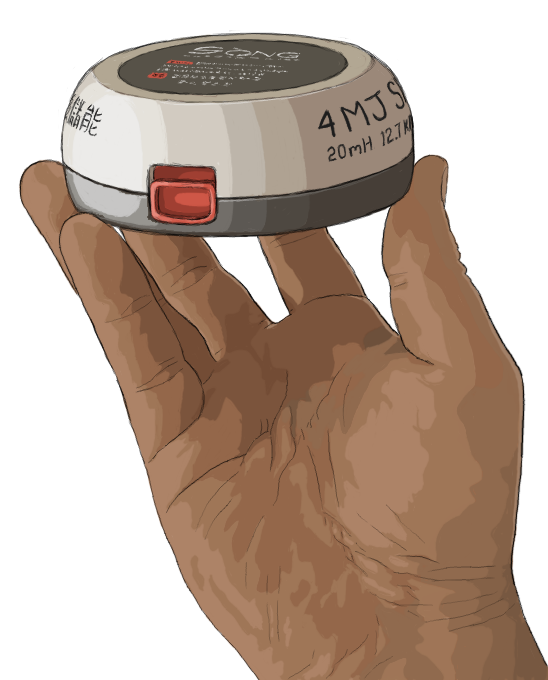 Puck SMES: A SMES ring about the size of a roll of packing tape or a bit larger than a standard hockey puck.
Puck SMES: A SMES ring about the size of a roll of packing tape or a bit larger than a standard hockey puck.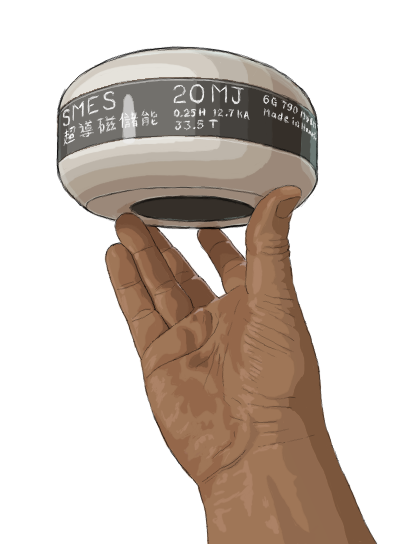
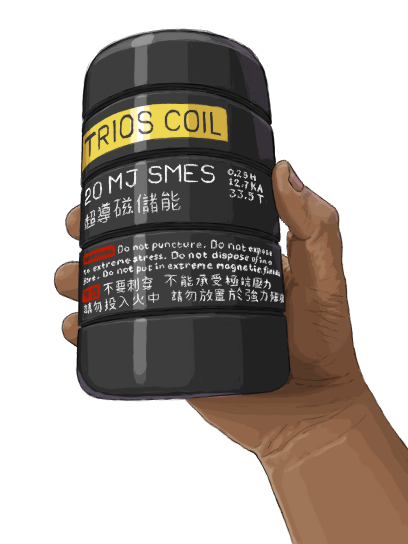
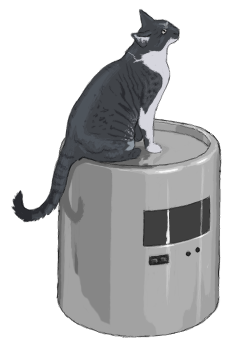 Household SMES: A backup power supply for a building, about the size of a trashcan or small refrigerator, capable of providing power on the order of a megasecond for a typical family house. A household SMES is usually directly wired in to the building's electrical system to automatically recharge when needed or to take over as a power supply when the grid power cuts out or is insufficient.
Household SMES: A backup power supply for a building, about the size of a trashcan or small refrigerator, capable of providing power on the order of a megasecond for a typical family house. A household SMES is usually directly wired in to the building's electrical system to automatically recharge when needed or to take over as a power supply when the grid power cuts out or is insufficient.